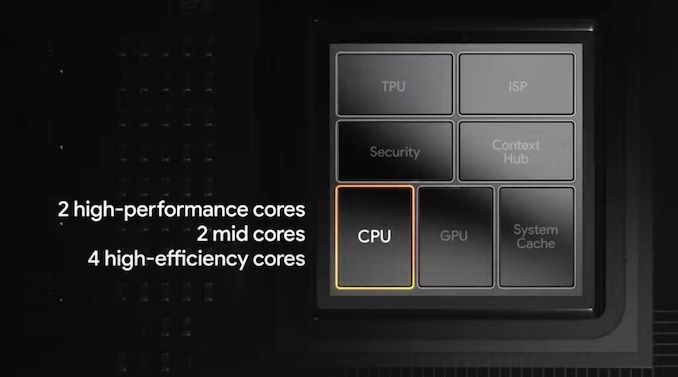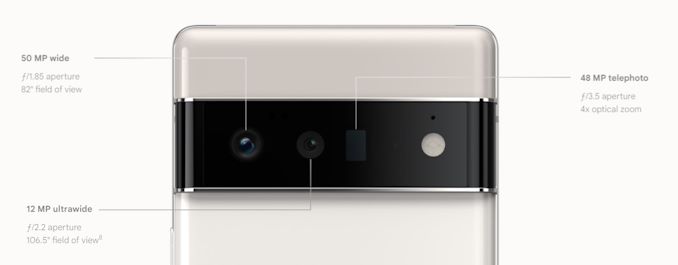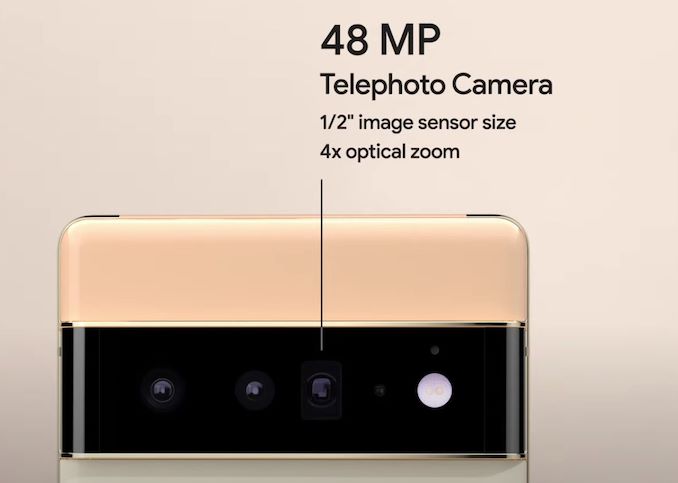
Original Link: https://www.anandtech.com/show/16939/google-announces-pixel-6-pixel-6-pro-the-new-real-flagship-pixels
Google Announces Pixel 6, Pixel 6 Pro: The New Real Flagship Pixels
by Andrei Frumusanu on October 19, 2021 4:30 PM EST- Posted in
- Smartphones
- Mobile
- Pixel 6
- Pixel 6 Pro
- Google Tensor
Today, after many weeks, even months of leaks and teasers, Google has finally announced the new Pixel 6 and Pixel 6 Pro – their new flagship line-up of phones for 2021 and carrying them over into next year. The two phones had been teased quite on numerous occasions and have probably one of the worst leak records of any phone ever, and today’s event revealed little unknowns, but yet still Google manages to put on the table a pair of very interesting phones, if not, the most interesting Pixel phones the company has ever managed to release.
Attacking the market with a two-prone approach, a more affordable “premium” range Pixel 6 starting at $599, essentially a similar price-bracket as the Pixel 5, yet with a much more capable phone, and what Google themselves call “their first true flagship”, the new Pixel 6 Pro, sporting all bells and whistles you expect from a contemporary high-end phone, yet still coming in at a quite reasonable $899.
Both phones are introducing new designs, new camera hardware, and new screens, but also quite interestingly, a new custom SoC which Google calls the “Tensor”.
| Google Pixel 6 Series | |||
| Pixel 6 | Pixel 6 Pro | ||
| SoC | Google "Tensor" 2x Cortex-X1 @ 2.80GHz 2x Cortex-A76 @ 2.25GHz 4x Cortex-A55 @ 1.80GHz Mali G78MP20 |
||
| DRAM | 8GB LPDDR5-6400 | 12GB LPDDR5-6400 | |
| Display | 6.4" AMOLED 2340 x 1080 90Hz Refresh |
6.71" AMOLED 3120 x 1440 120Hz VRR Refresh (LFD) |
|
| Size | Height | 160.4mm | 163.9mm |
| Width | 75.1mm | 75.8mm | |
| Depth | 8.2mm | 8.9mm | |
| Weight | 207g | 210g | |
| Battery Capacity | 4614mAh (Typical) 30W |
5003mAh (Typical) 30W |
|
| Wireless Charging | 21W | 23W | |
| Rear Cameras | |||
| Main | 50MP GN1 1/1.31" 1.2µm 4:1 Binning to 12.5MP / 2.4µm f/1.85 25mm eq. / 82° FoV OIS |
||
| Telephoto | - | 48MP IMX586 1/2.0" 0.8µm 4:1 Binning to 12MP / 1.6µm 4x Optical Periscope f/3.5 104mm eq. / 23.4° FoV OIS |
|
| Ultra-Wide | 12MP f/2.2 16.3mm eq. / 106.5° FoV |
||
| Extra | - | ||
| Front Camera | 8MP f/2.0 |
11.1MP f/2.2 |
|
| Storage | 128/256GB | ||
| I/O | USB-C | ||
| Wireless (local) | 802.11 (Wifi 6E), Bluetooth 5.2 |
||
| Cellular | 4G + 5G NR NSA+SA Sub-6GHz +mmWave (Select markets) |
||
| Special Features | Full-range stereo speakers | ||
| Splash, Water, Dust Resistance | IP68 | ||
| Dual-SIM | 1x nano-SIM + eSIM | ||
| Launch OS | Android 12 | ||
| Launch Price | 8+128GB: $599 / 649€ 8+256GB: $ / € |
12+128GB: $899 / 899€ 12+256GB: $ / € 12+512GB: $ / € |
|
Starting off with what is probably the most enigmatic part of the phones, the new Google Tensor: the company had teased the chip back almost 2 months ago, where we speculated our first ideas on the topic. Today, while generally not revealing too much new info, we can now officially confirm several specifications of the chip.
On the CPU side of things, Google went with a 2+2+4 CPU setup, with the top performance CPUs being Cortex-X1 cores at 2.8GHz. This is quite unusual as generally most other vendors had moved onto a single “peak” performance core, whereas Google here is employing two of them. Samsung in previous yeas always had 2 high performance cores for several of their Exynos SoCs in similar 2+2+4 setups, and while their custom CPUs were lacking, the setup itself with the core count seemed to be working well, so I find Google’s strategy here nothing too exotic.
What however is very exotic, is the usage of Cortex-A76 cores at 2.25GHz as the two middles cores of the setup. In interviews with other publications, Google explains that they’re going for better sustained performance at lower power levels, however for me this explanation makes absolutely no sense whatsoever, as both the A77 and A78 generations have large efficiency improvements included in their updated microarchitectures, and Qualcomm, SLSI and MediaTek all have good implementations of middle cores, which can go quite low in power consumption. Maybe Google is doing something here we don’t understand, and we’ll keep an open mind till we measure performance and efficiency, but it’s a very eye-brow raising aspect of the SoC.
Finally, the two X1 cores and two A76 cores are accompanied by four Cortex-A55 cores at 1.8GHz. Google had also confirmed the L3 cache comes in at 4MB, which is in line with the competition, and that we have a 8MB system cache, similar to what we see on the Exynos 2100.
The GPU is a Mali-G78MP20, which would make this amongst one of the largest implementations out there, just shy of the MP24 monster of the Kirin 9000. We don’t know yet the frequencies of the unit, but I suspect Google is running it slower to allow for better energy efficiency.
What was weird about today’s event is that Google had made no mention of Samsung, and presented the chip as purely a Google product. We’ve had seen rumours about a collaboration with Samsung LSI in terms of Google developing a custom chip for some time now, and seen evidence that the Tensor SoC is using quite a considerable amount of Exynos IP blocks. I’m not sure what kind of a deal the two companies have made in terms of marketing, but it’ll be definitely interesting to see the die shots of the chip and willing to make a few bets on the die marking showcasing “S5E9845”, let’s see how that pans out. The partnership with Samsung also would explain how Google is able to make an SoC with cellular connectivity – that is, if they’re indeed using a modem from Samsung. Google showcases different Pixel 6 models depending on whether they have mmWave or not, if we find a Qualcomm modem in there then that’d be quite an interesting development.
While the roots and foundations of the Tensor SoC remain hazy, what isn’t hazy is that the design definitely features some Google developed IP blocks, with as a fully new custom TPU (or NPU), designed by Google’s ML R&D groups to function best with Google’s own ML models, and custom ISPs, which also allow Google to accelerate image processing the way Google wants to do things, and which would differentiate the Pixel 6 phones from any other device in the market.
Particularly, Google explains that one killer feature enabled by the new ML capabilities is 30/60fps video processing where each frame has processing done to it via Google’s custom models, something which was previously not possible or achievable on other SoCs.
The phones come either in 8GB of LPDDR5 (Pixel 6), or 12GB (Pixel 6 Pro), with UFS 3.1 storage from 128GB, 256GB, or a Pro exclusive 512GB variant.
The Pixel 6 Pro is a quite feature rich device, most notably characterised by the 6.71” screen with 3120 x 1440 resolution. The display here is a LTPO/HOP panel with hardware variable refresh (LFD) with 10-120Hz refresh rates, just like what we see on Samsung’s Galaxy Note20 Ultra or S21 Ultra, meaning you should be able to enjoy 120Hz without major battery life impact. It remains to be seen if there’s some low brightness power compromise on the Pixel 6 Pro, or if Google managed to avoid the issue such as on the iPhone 13 Pro series.
The phone is large, but not overly so, with a footprint of 163.9 x 75.8mm, but is a bit thicker at 8.9mm. The weight here is 210g, so it’s a little lighter than an S21 Ultra, which is welcome. The battery is a “standard” 5000mAh for a phone of this size, so Google definitely doesn’t appear to have any weaknesses on the specs side of things for the 6 Pro.
The regular Pixel 6 is a bit more conservative in its design, mostly due to the display not having curved edges, and showcasing notably larger bezels. It’s a 6.4” screen with 2340 x 1080 resolution, and the OLED panel is only capable of 90Hz refresh rate, so I don’t expect any more advanced panel tech being employed.
With a 4614mAh battery, the phone’s footprint of 160.4 x 75.1mm isn’t actually very much smaller than that of the Pixel 6 Pro – so this isn’t a traditional case of the cheaper variant being smaller, it’s just simply cheaper. The weight of the phone is also only 3g lighter than the Pixel 6 Pro even though it lacks a whole camera module and has slightly smaller battery.
Both variants of the phones have IP68 rating, Wi-Fi 6E, and stereo speakers.
After many years of camera stagnation, the new Pixel 6 phones do a major revamp of the camera system this time around. First of all, in terms of design, Google is embracing the need for a camera bump, and have gone with this “bar” layout with the modules oriented across the width of the phone, which pretty much gives the new Pixel 6 devices an unmistakable look that I assume will define them in the general public. It looks good, and it’s something different to the many corner camera island designs we’ve seen from so many vendors.
The main camera sensor is now a 1/1.31” format Samsung GN1 sensor, with a native 50MP resolution and binning down via a Quad-Bayer colour filter to 12.5MP for regular shots. This is a massive hardware departure for the Pixel line-up, and the quite antiquated camera sensors we’ve seen used for many Pixel generations now. The aperture is f/1.85, and Google advertises a 82° field of view, which should correspond to a 25mm equivalent focal length.
The ultra-wide is a “normal” 12MP sensor, Google here doesn’t advertise is exact specifications, but the optics are quite average at f/2.2 and a 16.3mm equivalent focal length, or 106.5° FoV, which is a bit narrower than most other phones, but in line with what we’ve seen on the Pixel 5.
The Pixel 6 Pro exclusively has also a 48MP periscope telephoto. The magnification is 4x relative to the main sensor, and we should be seeing an IMX586 sensor here. Essentially, the specifications here are identical to the periscope telephoto of the Galaxy S20 Ultra, and I actually think that this is a good thing, as the 10x module of the S21 Ultra has a too great quality gap at intermediary magnifications, and the 6 Pro is able to take advantage of the dual resolution of the sensor to still allow both high-quality magnifications at 4x as well as 8x magnification.
In terms of photography, Google of course continues to use its proprietary image processing algorithms, and alongside the augmented video recording capabilities, we should also see great leaps in still image capture quality.
Extremely Competitive Pricing at $599 and $899
At a starting price of $599, the Pixel 6 is a quite cheap and affordable device, especially for US readers which typically have much less choices in this segment. The phone compromises quite a bit on the display, but should that be something you can live with, the package represents significantly higher value than what we’ve seen with the Pixel 5. European pricing is also interesting at 649€ - though here there are more options to consider.
The Pixel 6 Pro looks to me like an extremely well-balanced flagship device – and I would have very little in terms of reproach to any of its features or hardware specifications. At a starting price of $899, or 899€, it’s also starting less than what we’ve see on the S21 Ultra – naturally of course, the Pixel 6 Pro comes 8 months later.
Google’s pricing here seems to hit a sweet spot balance between what the devices deliver, and where the competition is situated, which is actually a pretty shocking development for the Pixel line-up, which in past years has seen confusion as o where Google wants to be heading with their phones. The one negative I’d mention is that Google still appears to have extremely spotty availability in some markets- the phone is unavailable in BeNeLux countries where I’m situated, which is always head-scratching. That being said, we’re looking forward to the Pixel 6 series, as it appears to be Google most solid ever Pixel releases, which an extremely positive development for the company’s smartphone business.












